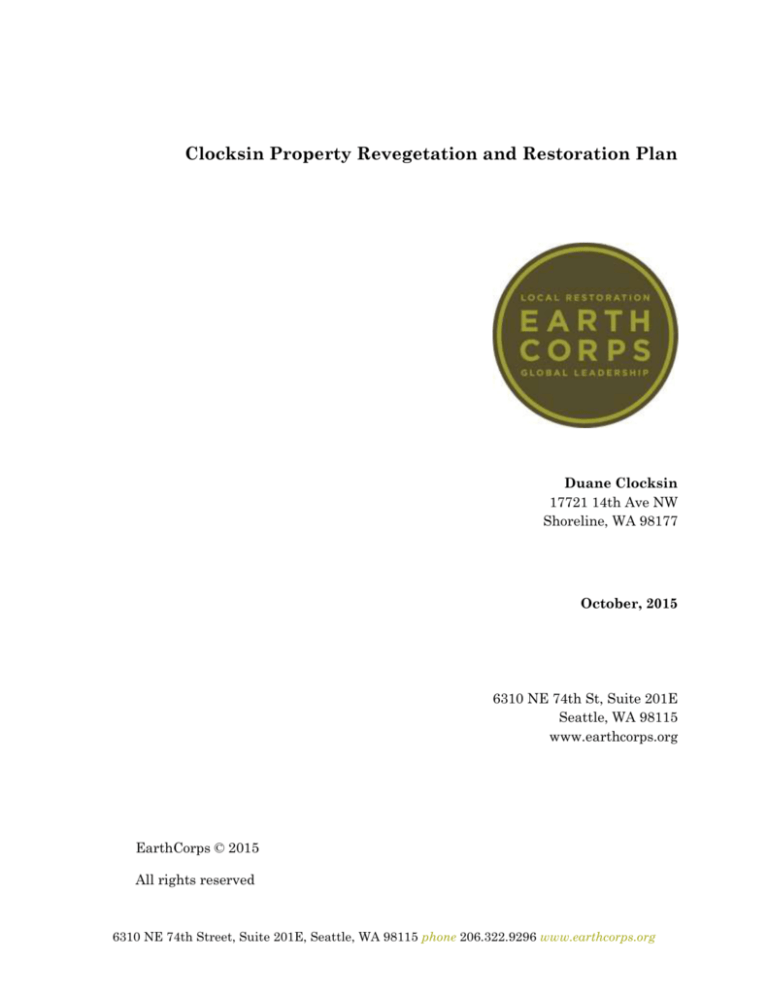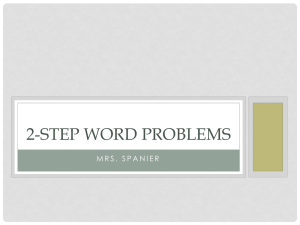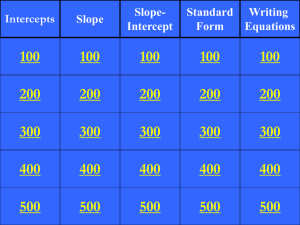
Clocksin Property Revegetation and Restoration Plan
Duane Clocksin
17721 14th Ave NW
Shoreline, WA 98177
October, 2015
6310 NE 74th St, Suite 201E
Seattle, WA 98115
www.earthcorps.org
EarthCorps © 2015
All rights reserved
6310 NE 74th Street, Suite 201E, Seattle, WA 98115 phone 206.322.9296 www.earthcorps.org
Introduction
This Plan addresses the revegetation of a section of a slope present on the western portion of the
property behind the residence located at 17721 14th Ave NW. During a field survey conducted on
July 29, 2015, a portion of the slope was examined in the vicinity of eight pruned trees – seven resprouted bigleaf maple (Acer macrophyllum) coppices and one non-native sweet cherry (Prunus
avium) tree (Figure 1 – Site Plan). All trees that were affected consisted of previously cut tree boles
that had extensively re-sprouted. During the course of this disturbance, other vegetation was
likewise impacted in the area. Most of the impacted vegetation was non-native invasive Himalayan
blackberry (Rubus bifrons) and non-native invasive hybrid Japanese knotweed (Polygonum
×bohemicum), with a small amount of native salmonberry (Rubus spectabilis) and western sword
fern (Polystichum munitum) also affected. Most of the impacted vegetation occurred on the
perimeter of the disturbed areas as the canopy from the pruned maples appeared to be limiting other
plant establishment. The undisturbed vegetation below and to the north of the affected area is
comprised primarily of Himalayan blackberry with lesser amounts of salmonberry, willow (Salix
spp.), and other species. See attached Site Plan for the locations of affected trees in the area and
proposed restoration vicinity.
The entire area of the disturbance is approximately 25 feet wide by 75 feet long down slope (see Site
Plan), much of which is covered by downed debris from the pruning. The upper portion of the
disturbed area is located on a relatively steep slope that is currently devoid of vegetation or debris,
approximately 20 feet wide and extending 30 feet down slope. The property owner has installed coir
fabric and coir erosion control logs on the face of this steep slope. In addition to the blackberry
clearing, a section of hybrid Japanese knotweed was cut back in a less steep portion of the hillside to
the north. At the time of the assessment, these plants had aggressively re-sprouted and showed no
signs of long term damage.
This Plan proposes a long-term strategy to revegetate the entire disturbed area with native plants to
increase habitat structure and to stabilize the slope against potential erosion.
Restoration Plan and Site Preparation
Before native plants are installed, it will first be necessary to remove any existing non-native
invasive plant species within the proposed restoration area in the direct vicinity of the affected trees
(see Site Plan). These species include Himalayan blackberry and hybrid Japanese knotweed. Most
of the Japanese knotweed is located further to the north on the slope and was only noted on the
northeast edge of the proposed restoration area. However, this species can spread aggressively and
will need to be controlled and kept from encroaching into the restoration site. It is recommended
that short term measures be taken to keep this species from spreading until a full eradication plan
can be implemented on the property. These measures could include hand digging new sprouts in the
restoration area or spot treatments with an approved herbicide. See King County Noxious Weeds for
more information: http://your.kingcounty.gov/dnrp/library/water-and-land/weeds/BMPs/KnotweedControl.pdf
Himalayan blackberry is only present within the proposed area in a limited distribution. These
plants should be controlled before planting to reduce competition and allow for more effective
maintenance of the site. Manual removal can be effective if the root ball is dug up, although care
needs to be taken to minimize soil disturbance. On steep slopes, blackberry canes can be cut and
6310 NE 74th Street, Suite 201E, Seattle, WA 98115 phone 206.322.9296 www.earthcorps.org
wiped with an approved herbicide (such as Roundup), which can be effective at killing the plant with
minimal disturbance to the soil. This method can also be effective to treat blackberry that is growing
through the installed erosion control fabric. See King County Noxious Weeds for more information:
http://your.kingcounty.gov/dnrp/library/water-and-land/weeds/BMPs/blackberry-control.pdf
In addition, some of the debris form the pruning may need to be cut and moved to facilitate invasive
species removal and planting efforts. It is recommended that this material be stacked to provide
habitat enhancing brush piles and allowed to decompose on-site.
Planting Plan
The approximate area addressed in this Plan to be revegetated is approximately 2,164 square feet
(see Site Plan). A portion of the steeper section of the upper slope has been covered with
biodegradable coir erosion control fabric in order to temporarily stabilize this area. The plan
proposes to plant native trees and shrubs across the entire affected area. A total of eight trees were
affected during the disturbance. All of the bigleaf maple trees that were cut were noted to be
actively re-sprouting at the time of the site visit and their living root systems should continue to help
maintain the structure of the slope.
We are proposing to replace all affected trees at more than the required ratio (see attached Tree
Retention Calculation Worksheet). Because of past pruning, affected trees did not have any
significant diameter at breast height at the time of the current shortening. Diameters were
measured at the point where the main stem was cut as indicated in the notes section of the
Worksheet. From these measurements, it is possible to infer the necessary tree replacement ratio
based on the diameter of the stem where it was pruned. From this analysis, it can be presumed that
a total of four trees were affected that could be considered Significant per the Shoreline Municipal
Code and four non-significant trees were affected, indicating a required replacement of ten trees.
This planting plan proposes that an additional tree is planted for every affected non-significant tree.
In addition, we are recommending that smaller tree stock is used to reduce slope disturbance during
planting, and therefore propose to increase tree replacement by an additional four trees (30%). The
total number of installed replacement trees will be 18 (see proposed plant selection below).
In addition to the replacement trees, the entire affected area will also be planted with a variety of
shrub and groundcover species (see below) in order to revegetate the affected area and stabilize the
slope.
All trees will be planted on approximately 10 foot centers and shrubs and low growing groundcovers
will be planted on approximately 4 foot centers throughout. Shrubs and groundcovers should be
selectively planted in groups or bunches of several different species in order to allow the plants best
suited for the slope environment to eventually dominate the plant community (as recommended by
WA DOE for slope stabilization and erosion control:http://www.ecy.wa.gov/programs/sea/pubs/9330/container.html). Trailing groundcovers will be planted primarily on the steeper slope on
approximately 2-3 foot centers interspersed with the bunched plantings. All plants should be
installed in winter (November-January) for the most effective root establishment.
6310 NE 74th Street, Suite 201E, Seattle, WA 98115 phone 206.322.9296 www.earthcorps.org
Proposed species selection:
Planting Plan
Plant Species
Steep Moderate
Slope Slope Size
Trees
Vine Maple
Black Hawthorn
Pacific Crab Apple
Cascara
Shrubs
30
Red Fllowering Current
Serviceberry
Snowberry
Oceanspray
Tall Oregon Grape
Red-twig Dogwood
Black Twinberry
Thimbleberry
10
Groundcovers
15
5
100
Sword Fern
Salal
Coastal Strawberry
15
10
75
TOTALS
130
Totals
Apprx.
distance
on center
18
6
6
4
2
1 gal
1 gal
1 gal
5 gal
18
6
6
4
2
10 feet
10 feet
10 feet
10 feet
55
10
5
10
5
5
10
5
5
1 gal
5 gal
1 gal
1 gal
1 gal
1 gal
1 gal
1 gal
85
20
5
25
5
5
10
5
5
4 feet
4 feet
4 feet
4 feet
4 feet
4 feet
4 feet
4 feet
1 gal
1 gal
4 inch
120
25
20
75
4 feet
4 feet
2-3 feet
20
10
10
93
223
Actual species and size may differ based on availability. Replacement species should be native to the
Pacific Northwest and demonstrated to provide erosion control and slope stabilization such as those
found on the WA DOE Plant Selection Guide (http://www.ecy.wa.gov/programs/sea/pubs/9330/table3.html).
All plants will be potted material and will be planted following typical installation techniques:
Loosen roots from soil, cut any circling roots, and remove as much of the pot substrate as
feasible (not into the planting hole).
Dig the planting hole at least twice the width of the root mass.
Arrange the roots evenly in the hole so they spread out and do not circle.
Backfill with native soil so root flair is even with grade and gently push down to ensure that
there are no air pockets
Create a shallow basin around the planting hole to catch water where appropriate.
Place a ring of arborist chips or composted bark around each plant at least six inches deep
for moisture retention and weed suppression
6310 NE 74th Street, Suite 201E, Seattle, WA 98115 phone 206.322.9296 www.earthcorps.org
Special considerations for planting on steep slopes:
Adjust grade around the planting hole as necessary to create a level area for installation.
Cut through erosion control fabric (where present) in a large enough radius in order to access
the soil for one gallon plantings.
Spreading ground cover in 4” pots can be installed in smaller holes through the coir.
Bunch plantings above installed coir logs for additional stability where possible.
Maintenance Plan
After planting (see Planting Plan above), the site will need to be maintained to ensure that the
installed plants remain healthy and become well established. Because of the aspect and exposure of
the slope, it is recommended that plants are irrigated during the dry months (June through
September) for the first two growing seasons. This could be accomplished with a drip irrigation
system or similar watering methods. The site will also need to be regularly maintained and cleared
of encroaching invasive species. In lieu of regular spot weeding, it is recommended that a landscape
crew visit the site at least twice a year for the first five years to remove or treat any weedy invasive
species, taking care to not disturb the slope or the native plantings.
Monitoring Plan
An EarthCorps Ecologist will monitor the site for a minimum of three years to ensure adequate
survival of all planted trees and shrubs. Monitoring reports will be prepared and submitted to the
homeowner at the end of each year. Reports will provide maintenance recommendations for the
following year and provide a vegetation replacement contingency plan in the event of any diminished
performance or mortality of the installed plants, as per standards identified in SMC 20.80.350(G).
All installed trees will be mapped and inventoried to ensure survival. In order to track vegetation
success of the shrub and groundcover plantings (excluding trailing groundcovers), monitoring plots
(or belt transects) will be established within one month of plant installation to establish an asplanted baseline. Sampling unit size will be determined on-site in a manner that ensures that at
least twenty percent of all installed shrubs and groundcovers are accounted for. All tree mortality
will be replaced at a one to one ratio. Shrub and groundcover (excluding trailing groundcovers) will
be replaced at a one to one ratio if percent mortality is projected to be greater than 80% of the as-
6310 NE 74th Street, Suite 201E, Seattle, WA 98115 phone 206.322.9296 www.earthcorps.org
planted baseline. Tree, shrub, and groundcover replacement plant species will consist of those
planted species observed on-site to have successfully established within the restoration area.
Monitoring visits will occur twice in the first year (one as-planted baseline and one end of season
monitoring) and then once a year at the end of each growing season (before the end of August)
thereafter. If monitoring in the third year indicates poor performance and contingency is still
necessary, the site will be monitored for an additional two years.
Projected Budget
The following information is provided as a best estimate for costs associated with invasive plant
control, plant material, planting labor, and monitoring services. These prices may change and need
to be renegotiated due to factors including availability of plant material, revisions to the planting
plan, additional monitoring requests or frequencies, etc. and are provided here as estimates only.
Revegetation
Site prep (includes labor and costs of herbicide)
Plant material (includes delivery)
Planting (includes staging, installation, and mulch)
Subtotal
Tax (9.5% of labor and materials)
Total
$
$
$
$
$
$
Cost
675
455
1,250
2,380
226
2,606
Monitoring
Year one (includes baseline establishment and monitoring report)
Year two (includes monitoring report)
Year three (includes monitoring report)
Total
$
$
$
$
1,380
920
920
3,220
$
$
$
920
920
1,840
$
5,826
Monitoring (Contingency)
Year four (if necessary)
Year five (if necessary)
Total
Total Projected Budget (excluding contingency)
Prepared by:
Nelson Salisbury, Ecologist
EarthCorps
nelson@earthcorps.org
206.322.9296 x214
6310 NE 74th Street, Suite 201E, Seattle, WA 98115 phone 206.322.9296 www.earthcorps.org






